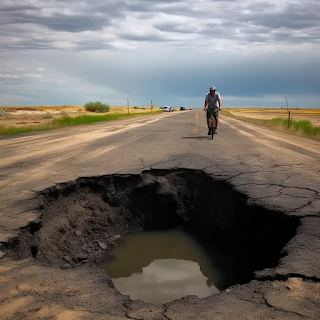Stay Safe on the Road: Tips for Avoiding Hazards While Riding Your Bicycle
Common Road Hazards:
Potholes: Potholes are a common road hazard that cyclists face. To avoid potholes, look ahead for potential hazards and steer around them if possible. If you can't avoid a pothole, slow down and rise up off your seat to help absorb the impact.
Gravel: Loose gravel on the road can be hazardous for cyclists, especially when turning or braking. To avoid slipping on gravel, slow down and take turns slowly and carefully. Also, be sure to leave plenty of room between you and the cyclist in front of you to avoid kicking up rocks and debris.
Railroad tracks: Crossing railroad tracks can be tricky for cyclists. To cross tracks safely, approach them at a 90-degree angle and maintain a steady speed. Also, be sure to keep your weight centered over your bike to help maintain control.
Car doors: Car doors that suddenly open into a cyclist's path are a significant hazard. To avoid being hit by a car door, give parked cars plenty of space and stay alert for signs that someone is about to exit the vehicle. Also, consider riding further to the left of the road to give yourself more room to maneuver.
Uneven surfaces: Uneven surfaces, such as speed bumps or cracked pavement, can be hazardous for cyclists, especially when riding at high speeds. To avoid crashes, slow down and approach these hazards with caution. Also, be sure to keep your weight centered over your bike to help maintain control.
Tips for Avoiding Road Hazards:
Be aware of your surroundings: Keep your eyes on the road and be aware of your surroundings at all times. Look ahead for potential hazards such as potholes, debris, and other obstacles. Stay alert for cars, pedestrians, and other cyclists as well.
Use hand signals: Using hand signals to indicate turns and stops can help alert drivers and other cyclists to your movements. This is especially important when riding in traffic or on busy roads.
Avoid distracted riding: Texting, listening to music, and other distractions can make it difficult to stay aware of your surroundings and react to hazards. Keep your focus on the road and avoid distractions while riding.
Ride defensively: Assume that drivers may not see you and take extra precautions to avoid accidents. This may include riding further to the right of the road or taking alternate routes to avoid busy or dangerous intersections.
Watch for weather conditions: Rain, snow, and other weather conditions can create hazards on the road. Slow down and take extra precautions in adverse weather conditions to avoid slipping or sliding on wet or icy roads.
Check your equipment: Regularly check your bicycle's brakes, tires, and other equipment to ensure that everything is in good working order. This can help prevent accidents caused by equipment failure.
Use proper lighting: When riding in low light conditions, such as at night or during dawn or dusk, it's important to use proper lighting on your bicycle. This can help you stay visible to drivers and avoid accidents.
By being aware of common road hazards and taking steps to avoid them, you can help stay safe while riding your bike. Always wear a helmet, obey traffic laws, and be courteous to other cyclists and drivers on the road. With these precautions in mind, you can enjoy all the benefits of cycling while minimizing your risk of injury or accident.
Here is my next blog post: The Joy of Solo Cycling: Embracing the Freedom of the Open Road




